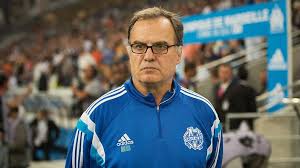By Samindra Kunti in Amsterdam
October 4 – Marcelo Bielsa is a revered man – for both his philosophy and methodology. The Argentine rarely appears in public, but at the Aspire4Sport Global Summit on Football Performance & Science in Amsterdam he delivered the keynote address and a fascinating insight into coaching theory and practice.
Who is the best coach in the world – read, not who has won the cabinets full of silverware, but rather whose tentacles of influence have spread the furthest? The godfather of football theory is the late Johan Cruyff, followed by his disciple Pep Guardiola, who is coaching Manchester City. And then? Possibly Bielsa?
The Argentine is an enigma. He confirmed that at the Amsterdam Arena. Bielsa walked around alone, unperturbed by the glamour, glitz and general air of expectation, or apprehension, that accompany semi-corporate events today in world football. He observed through his ribbed-glasses and kept to himself.
He didn’t toy with his phone. What would a text message to Bielsa look like? ‘Marcelo, 3-3-3-1?’ Once, on stage – in effect on the field’s touchline, where he tends to pace up and down and squat during matches – he was gripped by a compulsive passion for football theory.
“I have been thinking about player education for more than 25 years as a trainer and player,” said Bielsa. “I’ve been trying to educate and train players. Ideally, I would like to try and start training a player at the age of 13 and then work with him throughout his career, over a period of 10 to 15 years. I love football, the game, I adore it, but I really love the essence of it – the nature of the game is the most important thing. Those that can’t invent or don’t find solutions are the ones I want to help.”
“I have to make clear that everything you see [from my work] is not very original,” said Bielsa. “Xavi is here. He is good at being spontaneous and original, but he may think ‘Why am I doing what I am doing?’ Everything you see, I have copied.”
The coach from Rosario first gained global recognition while coaching Argentina from 1998 until 2004, a spell culminating in a gold medal victory at the 2004 Athens Olympic Games. At home, Bielsa suffered from cultural oppression as he didn’t adhere to Argentina’s footballing identity wherein a playmaking number 10 is key. Bielsa ostracized Juan Roman Riquelme, because he wasn’t compatible with his quest for all-encompassing dynamism.
On his next coaching assignment with the Chilean national team Bielsa faced less opposition to his ideas: the Chileans had tried to copycat Brazil, Argentina and several European countries, but failed to develop a footballing identity. Bielsa implemented his basic and favored tactical template, a 3-3-1-3 formation, with a central striker and overlapping wing backs. He instructed his team to mostly play in the opponent’s half. He guided Chile to the 2010 FIFA World Cup, where La Roja excelled to become the neutral’s favorite with attacking football in a tournament of prudent play.
Bielsa formations are the result of watching extraordinary amounts of football. What he sees, he categorises in up to more than 150 different sections. There are, for example, five ways for a player to lose his marker, according to Bielsa. He watched two hundred matches of Louis Van Gaal on video to get into the Dutch coach’s mind.
In substance Bielsa may not be innovative, but his methodology certainly is. “I look at rivals at how they play and what do they do,” explained Bielsa. “What can I change and how can I include it in my program? In five years [at youth level] I want to be able to train all of what I have seen – the problems and solutions.”
Bielsa dissects opponents in excruciating detail through video-analysing: how they recover possession, how they build up play and transition forward. He then breaks those moves down, pinpoints where possession can be regained and demands constant collective pressing from his players. They must also think in terms of shapes and patterns.
It’s the flip side to Bielsa’s manic inclination to attack, a nagging problem to Bielsisme: the physical demands on his players are simply too exhausting.
In Ligue 1 Bielsa’s Marseille led the table for seven months, before imploding in a whirlwind season which pitted Bielsa’s romanticism against the economic might of Paris Saint-Germain. A title would perhaps have been Bielsa’s greatest triumph. Marseille had all the ingredients of a typical Bielsa side – the running in block, the high-pressing and quick exchanges of passes, but physically they fell short.
Bielsa’s 2011/12 season at Athletic Bilbao in Spain is another perfect case-study. The Basque club defeated Manchester United over two legs in the Europa League’s round of sixteen in imitable style, but, by time of the final, Bilbao were a team bereft of energy and zeal, and were comprehensively beaten by Atletico Madrid. In the Copa del Rey, the Spanish Cup, the story of slick progress and an underwhelming performance in the final – against FC Barcelona – repeated itself.
But Bielsa is a purist, who won’t stop in his quest for ceaseless attacking and near-perfect football.
“My dream would be to have a team and at training an outsider would say – I don’t know which position he is playing in,” said Bielsa. “All players should be able to occupy more than just one position on the pitch.”
Contact the writer of this story at moc.l1713618418labto1713618418ofdlr1713618418owedi1713618418sni@i1713618418tnuk.1713618418ardni1713618418mas1713618418

